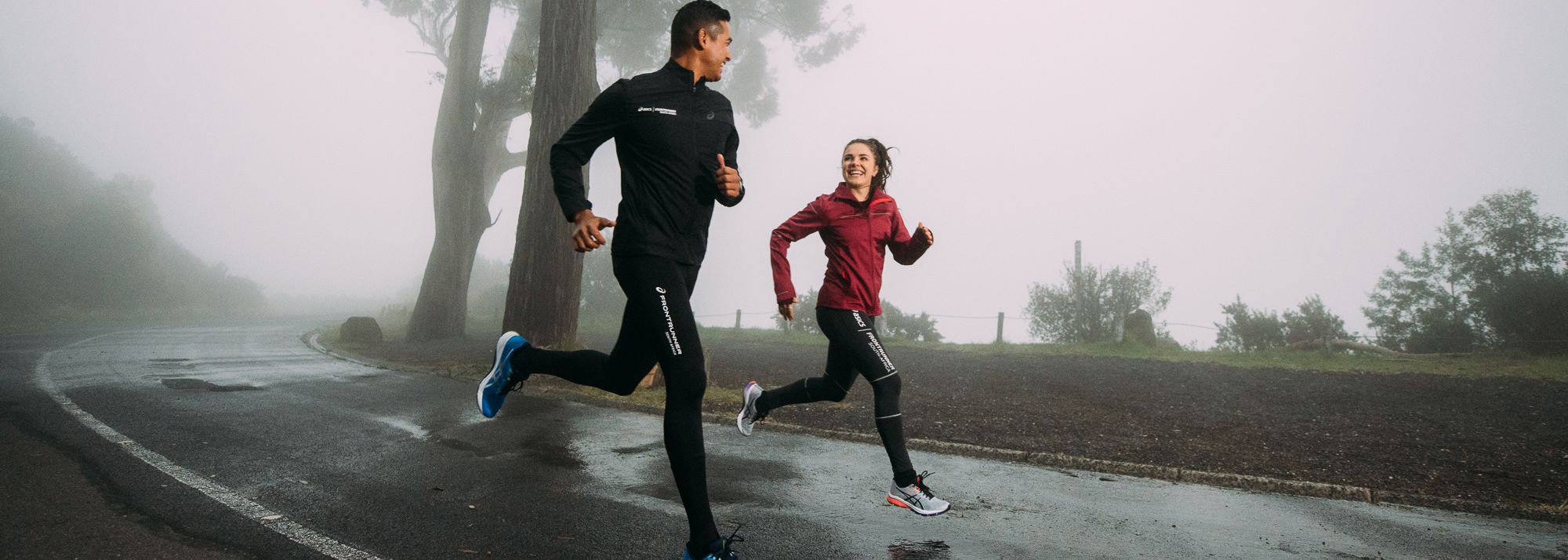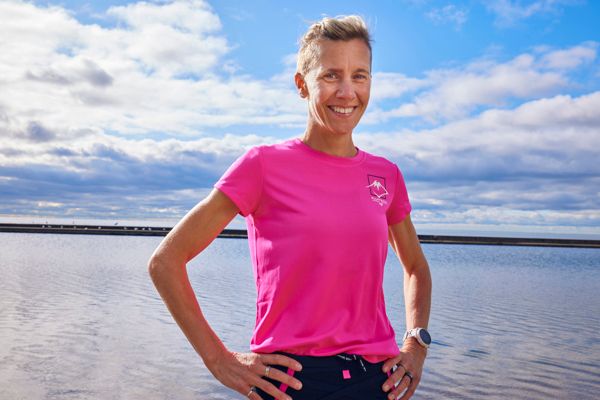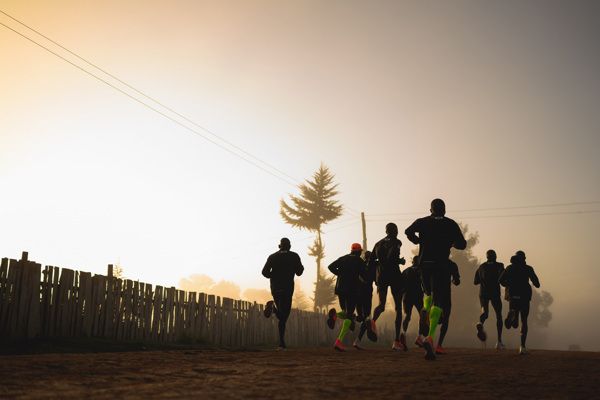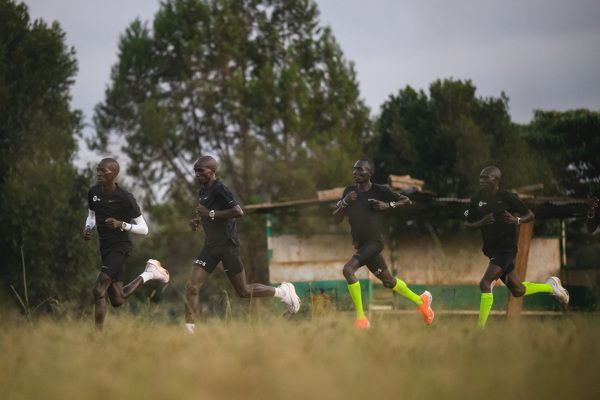Athletes training in cold weather (© Asics)
Cold temperatures and long, dark nights have arrived in the northern hemisphere. The autumn leaves are just about hanging on in their fiery, vibrant colours but winter feels almost around the corner.
For many athletes, the off-season is the time for consistent, comprehensive training which will form the foundation for the competition season. In some disciplines, such as cross country and road racing, competition continues through the winter, but nevertheless, this time of year is still useful for consolidating the basics. But what does this actually amount to in practice?
If you’re new to running, you may be wondering how to structure your winter training and how best to use this time. The key to making significant improvements in performance over time is consistent, specific training, and the winter is as good a time as any to do this.
I often get asked “how long should I train for to run a marathon?” This is akin to asking how long a piece of string is. You could probably run one off six months’ training, but to make meaningful, major improvements, you have to do consistent, specific training over a long period of time. So, what is the best way to organise and approach winter training?
I caught up with the coach of arguably the current ‘world’s best athlete’ to hear some answers to this question. That famous phrase is often used to describe the reigning Olympic decathlon champion, as the athlete who has triumphed in that ultimate, all-round test of athleticism. The coach of the current decathlon champion, Canadian Damian Warner, is Gar Leyshon, who has guided him since he was at school.
Warner won Olympic bronze in 2016, and two World Championships silvers and bronzes before finally landing the big one in Tokyo this August. Coaching Warner from a teenager who did no organised sport to Olympic gold at age 31, Leyshon has first-hand experience of producing a champion.
You might assume that Leyshon’s regime is complicated, very specialised and reliant on sophisticated sports science, but actually it is relatively straightforward. This is what I gleaned from the world’s best athlete’s coach about winter training.
First: variety is important.
Leyshon uses a range of activities over the winter, in order to include a wide variety of movements and to keep things interesting. This enables development of all the attributes athletes need – agility, mobility, strength, balance, speed, endurance and so on.
They do gymnastics for two months during the winter, play badminton (which mimics javelin) and basketball, plenty of throwing, medicine ball work, lateral movements and practising spinning. He doesn’t prepare too specifically for the actual events that make up a decathlon, but rather builds the athleticism which will enable good performance.
In a nutshell, he is preparing the fundamental physical capacity which will then enable the athlete to perform well in the specific events later.
View this post on Instagram
Second: make the most you possibly can of your warm-ups.
Leyshon believes full engagement in warm-ups is vital, and laments the lack of it that he often sees. “Warm-ups are so important, and can become a key part of your conditioning,” he explains.
Warner has been performing the same set of mobility exercises for a decade. This menu serves as a checklist that every joint and part of his body is ready to work. Leyshon likens this to a pilot checking everything in the cockpit before a flight. Warner performs his checklist and warm up as slowly and deliberately as he needs to, until he is fully ready to train. Being a familiar routine, Leyshon says it has a calming effect.
Third: exert yourself!
Leyshon recommends training which involves full exertion, because this will stimulate adaptation and improvement. But it needs to be in small amounts to enable full recovery and be sustainable over time.
“We try to do the least amount of work you can get away with,” he explains. “I dislike the idea of athletes grinding out their training. It is important to work hard, but training shouldn’t always be a grind – I prefer specificity and quality over volume and we often find that less is more.”
The concept of limiting the amount of training you do is something I’ve become particularly interested in as I get older, and is counter-intuitive for many endurance runners. By forcing yourself to do less, it makes you think very carefully about the content, and it motivates you to perform a session to the very best of your ability. “Everything we do must have a deliberate reason and purpose,” he says. And in one of his best nuggets of wisdom: “I don’t believe in doing anything slowly.”
Fourth: make it fun!
Leyshon strongly believes that training should be fun and engaging. For example, he uses skipping, hopping and bounding exercises which require full concentration as they are technically demanding. Drills, like for many athletes, are a staple but he always makes them engaging by using fast drills and single leg exercises. “When you’re running, everything is single leg.”
He also creates obstacle courses with a variety of equipment such as boxes and hurdles, because they call for varying levels of effort, so the athlete is forced to manage their effort – a critical skill in all events, but especially for combined events, both in training and competition. Leyshon also uses games: “everything we do, we turn it into competition.”
In the context of fun, the dreaded 1500m comes up in conversation. The pain of endurance running is often evident as the decathletes battle through their final event. Warner has been quoted as saying: “I don’t think I’ll ever find love for that event.” So Leyshon again tries to make it fun, by drafting in training partners, and breaking down the 1500m into smaller chunks in training. Using fun and innovative approaches to training which an athlete dislikes is really valuable.
Leyshon's top tips for recreational athletes to try in addition to their longer runs.
a) Short accelerations of up to 30 metres, going into a sprint of up to 100m, repeated ten times with a walk back recovery. This is a great session for practising maximal exertion, he says.
b) Hill repeats of different lengths with a fast effort uphill followed by a walk or easy jog back down. Running uphill develops power as well as speed and endurance. Leyshon especially recommends this session if you have limited time available, and to do fewer repetitions fast rather than many at a sub-maximal effort.
c) Medicine ball workouts of up to 20 minutes, including as many different ways of using the ball as you can, for example throwing, bouncing, rolling, kicking and slamming.
Finally, I asked Leyshon how he and Warner cope with the cold through the Canadian winter. During Covid lockdowns, they famously had to use an unheated ice hockey arena for training. “Learning to manage your internal temperature is a good skill for athletes,” Leyshon explains. “We do a lot of training at 100% effort – you can’t pole vault, for example, at less than 100% effort. There is plenty of stop-start in our training, so regulating temperature and not allowing yourself to get cold between efforts are essential.”
View this post on Instagram
Warner trains in multiple layers so that, depending on his activity level, he can put on or remove layers as necessary. “It’s always better to be too hot than too cold, and we sometimes repeat a bit of warm up if we get cold between efforts,” says Leyshon.
On top of managing the cold, Leyshon also insists that Warner does the very basics – food and sleep – properly to train successfully through winter. “Many athletes simply do not eat enough, and if you’re not sleeping eight or nine hours a night, you’re not doing your job.”
Overall, the key message I took away from discussing winter training with Leyshon was this: simple hard work on the basics, performed in a fun and engaging way while looking after yourself, will build the physical attributes you need to perform well and improve. This simple regime over many years has turned Warner into the world’s best athlete.
Mara Yamauchi for World Athletics Be Active







